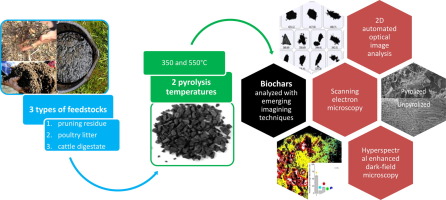Waste Management ( IF 7.1 ) Pub Date : 2020-03-02 , DOI: 10.1016/j.wasman.2020.02.037 Ilaria Piccoli , Armida Torreggiani , Chiara Pituello , Annamaria Pisi , Francesco Morari , Ornella Francioso

|
Biochar from agricultural biomasses and solid wastes represents a win-win solution for a rational waste management. Its sustainable usage requires the identification and standardization of biochar characteristics. The aim of this work was to identify the physical-chemical and spatial characteristics of biochars from pruning residues (PR), poultry litter (PL), and anaerobic cattle digestate (CD) at two pyrolysis temperatures (350 °C and 550 °C). The biochar characterization was carried out by applying emerging imaging techniques, 2D automated optical image analysis and hyperspectral enhanced dark-field microscopy (EDFM), and by SEM analysis. As predictable, the feedstock composition and the pyrolysis temperature strongly influence the physical structures of the biochar samples. Irrespective of charring temperature, PR biochar was mainly characterized by a broken and fragmented structure with an irregular and rough particle surface, completely different from the original PR wood cell. The EDFM imaging analysis evidenced the thermal degradation of PR vegetal products, composed primarily of hemicellulose, cellulose and lignin. On the contrary, small and regular particles with a smooth surface were produced by the PL pyrolysis, especially at 550 °C, due to the lower PL morphological homogeneity in comparison with the other biomasses. Finally, CD charring at both temperatures was characterized by changes in chemical composition, suggested by a lower pixel intensity. In conclusion, the emerging imaging techniques used in this study proved to be very effective in analyzing some properties of biochars, and can, therefore be considered as promising experimental strategies for detecting the feedstock and pyrolysis temperature of biochar.
中文翻译:

自动化的图像分析和高光谱图像,具有增强的暗场显微镜,可应用于在不同温度下产生的生物炭
来自农业生物质和固体废物的生物炭代表了合理废物管理的双赢解决方案。其可持续利用需要对生物炭特性进行识别和标准化。这项工作的目的是在两个热解温度(350°C和550°C)下,从修剪残留物(PR),家禽垫料(PL)和厌氧牛消化物(CD)中识别生物炭的物理化学和空间特征。 。通过应用新兴的成像技术,2D自动光学图像分析和高光谱增强暗场显微镜(EDFM)以及SEM分析来进行生物炭表征。可以预见,原料组成和热解温度会强烈影响生物炭样品的物理结构。不论炭化温度如何 PR生物炭的主要特征是破碎和破碎的结构,具有不规则且粗糙的颗粒表面,与原始PR木材细胞完全不同。EDFM成像分析证明PR植物产品的热降解,主要由半纤维素,纤维素和木质素组成。相反,由于PL形态均质性比其他生物质低,因此PL热解产生了小的且规则的表面光滑的颗粒,尤其是在550°C时。最后,两种温度下的CD炭化都以化学成分变化为特征,这是由较低的像素强度暗示的。总而言之,这项研究中使用的新兴成像技术被证明在分析生物炭的某些特性方面非常有效,并且可以











































 京公网安备 11010802027423号
京公网安备 11010802027423号